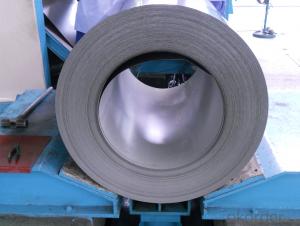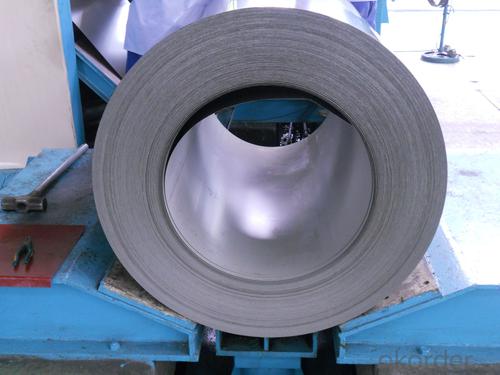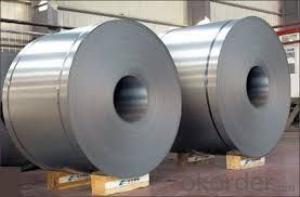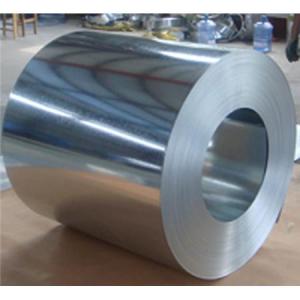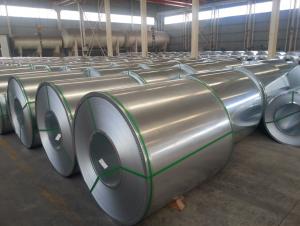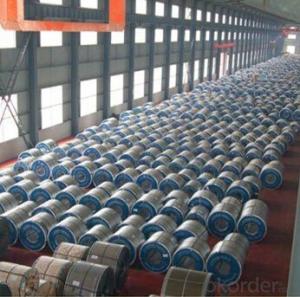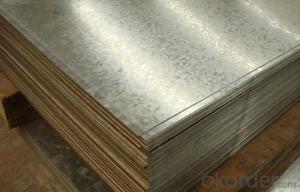Hot Dipped Galvanized Steel Coil/Sheet-EN10327 DX51D+Z
- Loading Port:
- Tianjin
- Payment Terms:
- TT OR LC
- Min Order Qty:
- -
- Supply Capability:
- 15000 m.t./month
OKorder Service Pledge
OKorder Financial Service
You Might Also Like
Galvanized steel coils are widely used in the construction industry, as raw material for the production of corrugated panels, fencing products, drywall panel profiles, ventilation systems etc. Recommended for both outside and inside usage, galvanized steel has a high resistance to corrosion in different environments, due to a protective layer of zinc of 100 – 180 grams per square metre.
Galvanized steel sheet /coil features:
1. Zinc coating :60-220g/m2( as required)
2. Thickness:0.13-3.0mm
3. Width:600-1250mm(900mm,1215mm,1250mm,1000mm the most common)
4. Coil id:508mm
5. Coil weight: 3-5MT(as required)
6. Surface:regular/mini/zero spangle, chromated, skin pass, dry etc.
7. Application: With excellent cold bending molded manufacturablity, good decoration effect, strong anti-corrosion ability, galvanized steel coils and sheets are also pollution-free and easily recycled. Accordingly, they can be used as final products and basic plates of color coated steel coils and widely applied in construction, home appliances, decoration, ect.
- Q: What are the quality standards for steel coil manufacturing?
- The quality standards for steel coil manufacturing typically include factors such as dimensional accuracy, surface finish, mechanical properties, chemical composition, and adherence to industry-specific standards set by organizations like ASTM or ISO.
- Q: Where can you buy a steel polearm in a shop or if someone has a file in Scania than can you sell me one ill buy it for 150k my account is tonypark500
- Steel polearm was from the Aran Welcome Event, which ended a few weeks ago. Now is the worst time to buy one, since the craze just ended and steel polearms are now heavily in demand (sadly). Your best bet is the free market, but they will cost you a few mil.
- Q: How are steel coils protected against fire and heat?
- To ensure the safety of steel coils, various methods are used to protect them from fire and heat. One effective way is by applying a fire-resistant coating, which acts as a barrier between the steel surface and the heat source. This coating prevents direct contact and reduces the chances of ignition or damage. Aside from coatings, steel coils can also be stored in fire-resistant warehouses or storage facilities. These structures are built with fire-resistant materials like concrete or steel and equipped with fire suppression systems such as sprinklers or fire extinguishers. These measures help contain and suppress any potential fire, effectively limiting its spread and safeguarding the steel coils. Furthermore, facilities that handle steel coils often implement fire safety protocols and procedures. These may include regular fire drills, training programs for employees on fire prevention and response, and the installation of fire safety equipment like fire alarms and fire hoses. These measures ensure that any fire incidents can be quickly detected and addressed, minimizing the risk to the steel coils. Overall, protecting steel coils against fire and heat involves a combination of fire-resistant coatings, proper storage in fire-resistant structures, and the implementation of fire safety protocols. These measures work together to mitigate the risk of fire and heat-related damage, ensuring the integrity and safety of the steel coils.
- Q: What are the dimensions of steel coils used in the furniture industry?
- The dimensions of steel coils used in the furniture industry can vary, but common sizes range from 0.5 to 3 millimeters in thickness and 100 to 2000 millimeters in width. The length can be customized based on specific furniture manufacturing requirements.
- Q: What are the different methods of coil recoiling for steel coils?
- There are several methods of coil recoiling for steel coils, including slitting, rewinding, and recoiling. Slitting involves cutting the coil into narrower strips, while rewinding involves unwinding the coil and rewinding it onto a new spool. Recoiling, on the other hand, is the process of rewinding the coil onto the same spool. These methods allow for the customization of coil width and length to meet specific requirements and facilitate easier handling and transportation.
- Q: How are steel coils used in the production of steel brackets?
- Steel coils are used in the production of steel brackets by being processed and cut into the desired shape and size. The coils serve as the primary raw material, providing the necessary strength and durability for the brackets.
- Q: Can steel coils be coated with aluminum?
- Yes, steel coils can be coated with aluminum. This process is commonly known as the coil coating or the prepainting process, where a layer of aluminum is applied onto the steel coils to enhance their corrosion resistance and improve their aesthetic appearance.
- Q: what do you think about producebility of low density steel? for example: can density of 1020 steel (or ony others) be decreased without any loss of other properties.
- 1. A method has been developed for magnetic phase analysis of Fermanal type alloys as-quenched and after aging. 2. The upper limit of alloying to ensure the optimal mechanical properties was determined more precisely for steel 9G28Yu9MVB. For rods aged at 550°C for 16 h the aluminum content should not exceed 9.2% and the carbon content 0.92%. 3. To ensure the optimal mechanical properties of the deformed metal it is necessary to obtain a fine-grained single-phase austenitic structure after quenching. The amount of hardening phase after quenching should not exceed 15–20% (saturation magnetization around 1600 G).
- Q: How are steel coils used in the production of furniture components?
- Steel coils are commonly used in the production of furniture components as they provide a strong and durable material for construction. These coils can be shaped, cut, and formed into various components such as frames, supports, and brackets, adding strength and stability to the furniture. Additionally, steel coils can be coated or painted to enhance their appearance and protect against corrosion, making them versatile and long-lasting materials for furniture manufacturing.
- Q: Can steel coils be coated with magnetic materials?
- Yes, steel coils can be coated with magnetic materials.
Send your message to us
Hot Dipped Galvanized Steel Coil/Sheet-EN10327 DX51D+Z
- Loading Port:
- Tianjin
- Payment Terms:
- TT OR LC
- Min Order Qty:
- -
- Supply Capability:
- 15000 m.t./month
OKorder Service Pledge
OKorder Financial Service
Similar products
Hot products
Hot Searches
Related keywords
